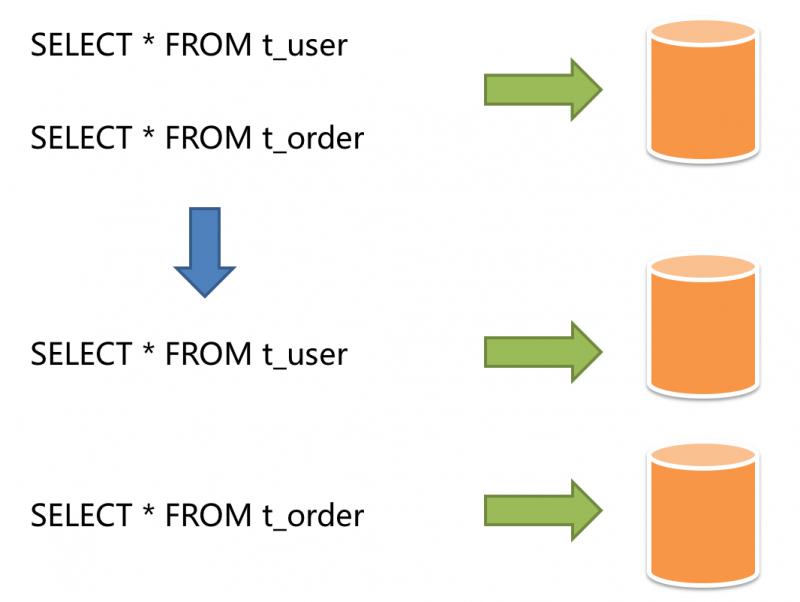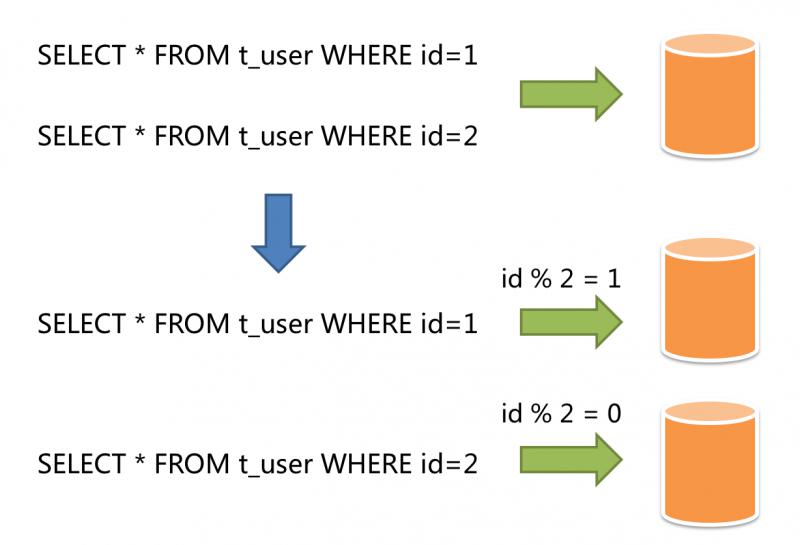Springboot2.x + ShardingSphere 實現分庫分表
之前一篇文章中我們講了基於Mysql8的讀寫分離(文末有連結),這次來說說分庫分表的實現過程。
概念解析
垂直分片
按照業務拆分的方式稱為垂直分片,又稱為縱向拆分,它的核心理念是專庫專用。 在拆分之前,一個數據庫由多個數據表構成,每個表對應著不同的業務。而拆分之後,則是按照業務將表進行歸類,分佈到不同的資料庫中,從而將壓力分散至不同的資料庫。 下圖展示了根據業務需要,將使用者表和訂單表垂直分片到不同的資料庫的方案。

垂直分片往往需要對架構和設計進行調整。通常來講,是來不及應對網際網路業務需求快速變化的;而且,它也並無法真正的解決單點瓶頸。 垂直拆分可以緩解資料量和訪問量帶來的問題,但無法根治。如果垂直拆分之後,表中的資料量依然超過單節點所能承載的閾值,則需要水平分片來進一步處理。
水平分片
水平分片又稱為橫向拆分。 相對於垂直分片,它不再將資料根據業務邏輯分類,而是通過某個欄位(或某幾個欄位),根據某種規則將資料分散至多個庫或表中,每個分片僅包含資料的一部分。 例如:根據主鍵分片,偶數主鍵的記錄放入0庫(或表),奇數主鍵的記錄放入1庫(或表),如下圖所示。

水平分片從理論上突破了單機資料量處理的瓶頸,並且擴充套件相對自由,是分庫分表的標準解決方案。
開發準備
分庫分表常用的元件就是shardingsphere,目前已經是apache頂級專案,這次我們使用springboot2.1.9 + shardingsphere4.0.0-RC2(均為最新版本)來完成分庫分表的操作。
假設有一張訂單表,我們需要將它分成2個庫,每個庫三張表,根據id欄位取模確定最終資料的位置,資料庫環境配置如下:
- 172.31.0.129
- blog
- t_order_0
- t_order_1
- t_order_2
- blog
- 172.31.0.131
- blog
- t_order_0
- t_order_1
- t_order_2
- blog
三張表的邏輯表為t_order,大家可以根據建表語句準備好其他所有資料表。
DROP TABLE IF EXISTS `t_order_0; CREATE TABLE `t_order_0` ( `id` bigint(20) NOT NULL, `name` varchar(255) DEFAULT NULL COMMENT '名稱', `type` varchar(255) DEFAULT NULL COMMENT '型別', `gmt_create` timestamp NULL DEFAULT CURRENT_TIMESTAMP ON UPDATE CURRENT_TIMESTAMP COMMENT '建立時間', PRIMARY KEY (`id`) ) ENGINE=InnoDB DEFAULT CHARSET=utf8mb4 COLLATE=utf8mb4_0900_ai_ci;
注意,千萬不能將主鍵的生成規則設定成自增長,需要按照一定規則來生成主鍵,這裡使用shardingsphere中的SNOWFLAKE俗稱雪花演算法來生成主鍵
程式碼實現
- 修改pom.xml,引入相關元件
<properties>
<java.version>1.8</java.version>
<mybatis-plus.version>3.1.1</mybatis-plus.version>
<sharding-sphere.version>4.0.0-RC2</sharding-sphere.version>
</properties>
<dependencies>
<dependency>
<groupId>org.springframework.boot</groupId>
<artifactId>spring-boot-starter-web</artifactId>
</dependency>
<dependency>
<groupId>org.mybatis.spring.boot</groupId>
<artifactId>mybatis-spring-boot-starter</artifactId>
<version>2.0.1</version>
</dependency>
<dependency>
<groupId>mysql</groupId>
<artifactId>mysql-connector-java</artifactId>
<version>8.0.15</version>
</dependency>
<dependency>
<groupId>com.baomidou</groupId>
<artifactId>mybatis-plus-boot-starter</artifactId>
<version>${mybatis-plus.version}</version>
</dependency>
<dependency>
<groupId>org.apache.shardingsphere</groupId>
<artifactId>sharding-jdbc-spring-boot-starter</artifactId>
<version>${sharding-sphere.version}</version>
</dependency>
<dependency>
<groupId>org.apache.shardingsphere</groupId>
<artifactId>sharding-jdbc-spring-namespace</artifactId>
<version>${sharding-sphere.version}</version>
</dependency>
<dependency>
<groupId>org.projectlombok</groupId>
<artifactId>lombok</artifactId>
<optional>true</optional>
</dependency>
<dependency>
<groupId>org.springframework.boot</groupId>
<artifactId>spring-boot-starter-test</artifactId>
<scope>test</scope>
</dependency>
</dependencies>
<build>
<plugins>
<plugin>
<groupId>org.springframework.boot</groupId>
<artifactId>spring-boot-maven-plugin</artifactId>
</plugin>
</plugins>
</build>- 配置mysql-plus
@Configuration
@MapperScan("com.github.jianzh5.blog.mapper")
public class MybatisPlusConfig {
/**
* 攻擊 SQL 阻斷解析器
*/
@Bean
public PaginationInterceptor paginationInterceptor(){
PaginationInterceptor paginationInterceptor = new PaginationInterceptor();
List<ISqlParser> sqlParserList = new ArrayList<>();
sqlParserList.add(new BlockAttackSqlParser());
paginationInterceptor.setSqlParserList(sqlParserList);
return new PaginationInterceptor();
}
/**
* SQL執行效率外掛
*/
@Bean
// @Profile({"dev","test"})
public PerformanceInterceptor performanceInterceptor() {
return new PerformanceInterceptor();
}
}- 編寫實體類Order
@Data
@TableName("t_order")
public class Order {
private Long id;
private String name;
private String type;
private Date gmtCreate;
}- 編寫DAO層,OrderMapper
/**
* 訂單Dao層
*/
public interface OrderMapper extends BaseMapper<Order> {
}- 編寫介面及介面實現
public interface OrderService extends IService<Order> {
}
/**
* 訂單實現層
* @author jianzh5
* @date 2019/10/15 17:05
*/
@Service
public class OrderServiceImpl extends ServiceImpl<OrderMapper, Order> implements OrderService {
}- 配置檔案(配置說明見備註)
server.port=8080
# 配置ds0 和ds1兩個資料來源
spring.shardingsphere.datasource.names = ds0,ds1
#ds0 配置
spring.shardingsphere.datasource.ds0.type = com.zaxxer.hikari.HikariDataSource
spring.shardingsphere.datasource.ds0.driver-class-name = com.mysql.cj.jdbc.Driver
spring.shardingsphere.datasource.ds0.jdbc-url = jdbc:mysql://192.168.249.129:3306/blog?characterEncoding=utf8&zeroDateTimeBehavior=convertToNull&useSSL=false
spring.shardingsphere.datasource.ds0.username = root
spring.shardingsphere.datasource.ds0.password = 000000
#ds1 配置
spring.shardingsphere.datasource.ds1.type = com.zaxxer.hikari.HikariDataSource
spring.shardingsphere.datasource.ds1.driver-class-name = com.mysql.cj.jdbc.Driver
spring.shardingsphere.datasource.ds1.jdbc-url = jdbc:mysql://192.168.249.131:3306/blog?characterEncoding=utf8&zeroDateTimeBehavior=convertToNull&useSSL=false
spring.shardingsphere.datasource.ds1.username = root
spring.shardingsphere.datasource.ds1.password = 000000
# 分庫策略 根據id取模確定資料進哪個資料庫
spring.shardingsphere.sharding.default-database-strategy.inline.sharding-column = id
spring.shardingsphere.sharding.default-database-strategy.inline.algorithm-expression = ds$->{id % 2}
# 具體分表策略
# 節點 ds0.t_order_0,ds0.t_order_1,ds1.t_order_0,ds1.t_order_1
spring.shardingsphere.sharding.tables.t_order.actual-data-nodes = ds$->{0..1}.t_order_$->{0..2}
# 分表字段id
spring.shardingsphere.sharding.tables.t_order.table-strategy.inline.sharding-column = id
# 分表策略 根據id取模,確定資料最終落在那個表中
spring.shardingsphere.sharding.tables.t_order.table-strategy.inline.algorithm-expression = t_order_$->{id % 3}
# 使用SNOWFLAKE演算法生成主鍵
spring.shardingsphere.sharding.tables.t_order.key-generator.column = id
spring.shardingsphere.sharding.tables.t_order.key-generator.type = SNOWFLAKE
#spring.shardingsphere.sharding.binding-tables=t_order
spring.shardingsphere.props.sql.show = true- 編寫單元測試,檢視結果是否正確
public class OrderServiceImplTest extends BlogApplicationTests {
@Autowired
private OrderService orderService;
@Test
public void testSave(){
for (int i = 0 ; i< 100 ; i++){
Order order = new Order();
order.setName("電腦"+i);
order.setType("辦公");
orderService.save(order);
}
}
@Test
public void testGetById(){
long id = 1184489163202789377L;
Order order = orderService.getById(id);
System.out.println(order.toString());
}
}在資料表中檢視資料,確認資料正常插入

至此分庫分表開發完成
往期回顧
SpringBoot+Mysql8實現讀寫分離
歡迎關注我的個人公眾號:JAVA日知錄
